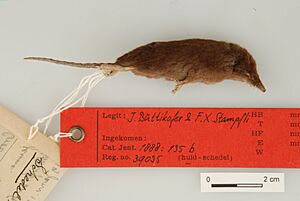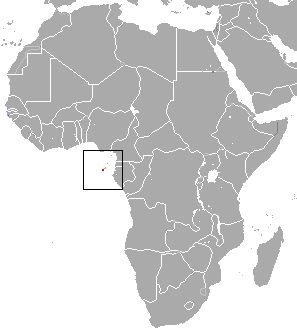São Tomé shrew facts for kids
Quick facts for kids São Tomé shrew |
|
|---|---|
 |
|
| Crocidura thomensis | |
| Conservation status | |
| Scientific classification | |
 |
|
| São Tomé shrew range |
The São Tomé shrew (scientific name: Crocidura thomensis) is a tiny mammal. It's a type of white-toothed shrew, which means it has white teeth! This little creature is only about 7.6 centimeters (3 inches) long. You can find it only on São Tomé Island, which is part of the country São Tomé and Príncipe. This island is actually a volcano that comes out of the Atlantic Ocean! The São Tomé shrew is very rare. It was first discovered in 1886. Sadly, its numbers are still going down. Because of this, it is listed as an endangered species.
Contents
Why the São Tomé Shrew Is in Danger
The São Tomé shrew faces big problems that threaten its survival.
Habitat Loss from Deforestation
One of the biggest dangers is deforestation. This means people are cutting down the forests where the shrews live. When their homes disappear, these small animals have nowhere to go. Their living space becomes very limited.
New Animals Competing for Food
Another problem is new animals being brought to the island. Sometimes this happens by accident, and sometimes on purpose. These new animals compete with the shrews for food. This makes it harder for the shrews to find enough to eat.
Helping the São Tomé Shrew Survive
People are trying to help the São Tomé shrew, but it's been difficult.
Challenges in Conservation
It's hard to protect these shrews because we don't have much information about them. Scientists need to learn more about their lives. This includes what they eat, how they reproduce, and where they prefer to live.
Changing Conservation Status
In 2004, a group called the International Union for Conservation of Nature (IUCN) said the São Tomé shrew was "critically endangered." This is the highest level of danger! At that time, they thought the shrew lived in only one small area. This area was a moist tropical forest on a mountain. People were turning this forest into gardens and farms. This was making the shrew's numbers drop even faster.
But then, good news came! Between 2002 and 2014, scientists found 23 shrews in 15 new places. This showed that they lived in more areas than first thought. Because of this, in 2016, the IUCN changed its status. It is now listed as "endangered" instead of "critically endangered." While still in danger, this change gives hope that we can help them survive.


